|
Dear
Friends,
In
my last newsletter, I said I would return
to the issue of ceremonies and Buffalo
Medicine. Such ceremonies can range from
specific Buffalo Dances to honor this
animal, to hunting preparations, to blessing
the parts of Buffalo's Body used by the
village, or to specific ceremonies revealed
to the people through engagement with
Buffalo Spirit.
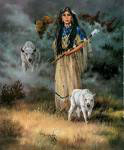 Inevitably
any discussion of Buffalo Medicine and
attendant ceremonies leads to a focus
on White Buffalo Woman. That's because
nearly all the enduring ceremonies have
their origin in Her appearance and the
messages She brought to the People. The
subsequent Buffalo ceremonies and dances
that evolved were ways to both enact
and remind the People of their Covenant
to continually transform their lives
so as to live in balance and respect
for All. Inevitably
any discussion of Buffalo Medicine and
attendant ceremonies leads to a focus
on White Buffalo Woman. That's because
nearly all the enduring ceremonies have
their origin in Her appearance and the
messages She brought to the People. The
subsequent Buffalo ceremonies and dances
that evolved were ways to both enact
and remind the People of their Covenant
to continually transform their lives
so as to live in balance and respect
for All.
In other words, whether from journeys or
visions, any seemingly new ceremonies
we might receive are connected with a
long, long history of the Humans' relationship
with Buffalo.
So
it is important we give some attention
to the story of White Buffalo Woman and
the Seven Sacred Rites She brought to
the People. Embedding ourselves for a
moment in this story raises the significance
of knowing the historical context for
the current practices of shamanism. There
is value in the core shamanism approach
while at the same time, we can lose relationship
with all who have lived before and tendered
for us profound understandings. We can
become so enamored of the Here and Now
that the Then and There simply slides
from consciousness. I tend to think of
this as severing the Tree from its roots
and living only in the Branches. Eventually
they, too, will disappear for these roots
sustain the whole Tree.
In
the following paragraphs, I am going
to provide a historical context from
which to view ceremonies of Buffalo,
the story of White Buffalo Woman, and
some discussion of the Seven Sacred Rites
given to the People. This is a longer
newsletter than I usually will be writing
but given the subject matter the respect
it is due requires this. Since reading
text on the computer screen can be demanding
on the eyes, you might want to read a
section, pause, and return to the next
ones later.
When
the People are Imperiled...
It is important to remember that White
Buffalo Woman came at a time of seeming
scarcity of food and shelter, a time
of violence within one's own tribe, a
time of making war on others considered
to be "not of me or mine," and a time
of great grief arising from the loss
of so many to the cycles of war and violence.
In short, it was a time of profound dispiritedness
in which the very Soul of the People
seems to have fled and cannot be found
or returned. The recognition of the Soul's
departure rose to a critical awareness
just as Winter was arriving with its
seasonal challenge to the People: "how
shall we survive, much less thrive, in
the coming long dark coldness." This
can be perceived as both literal (the
season Winter) and metaphor (the long
darkness in our lives as a People).
During
all such times, there are some who go
beyond the known limits or present boundaries
in search of finding that which will
return health and spirit to the People.
In this particular story, two young warriors
go in search of provisions that will
enable the People to survive. And in
case there is any forgetting of their
purpose, the story is quite instructive
here.
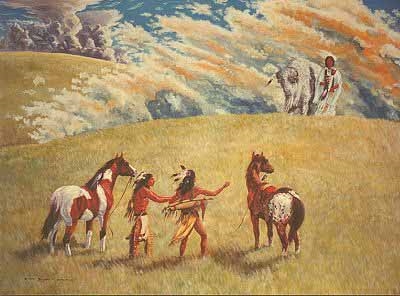 For
when they sight this Being, that turns
from a seeming White Buffalo into a Woman
clothed in Winter White garments, one
of the two men immediately seeks to possess
Her for himself; the other immediately
thinks of his people and wonders what
help She brings for them. The self-desiring
one ('this is for me') approaches Her
and immediately dissolves into bones
at Her feet. The other one is called
forth to Her; She tells him to return
to the village and tell the People to
prepare for Her coming for She brings
special help to them. For
when they sight this Being, that turns
from a seeming White Buffalo into a Woman
clothed in Winter White garments, one
of the two men immediately seeks to possess
Her for himself; the other immediately
thinks of his people and wonders what
help She brings for them. The self-desiring
one ('this is for me') approaches Her
and immediately dissolves into bones
at Her feet. The other one is called
forth to Her; She tells him to return
to the village and tell the People to
prepare for Her coming for She brings
special help to them.
The
young warrior rushes back to his village
and shares his encounter with this special
spiritual Being who seems to shapeshift
from a White Buffalo to a Woman clothed
in Garments White. He tells the people
they must make preparations for her arrival
for she will come in just a few days.
And for the first time, a sense of hope
arises that they have not been left completely
bereft and, indeed, that help from Great
Spirit is coming to them.
Upon
Her arrival She reminds them of the ways
in which they have fallen out of balance
and how all other Beings around them
have withdrawn from their presence. Yet
She assures them that they shall be transformed
if they practice the Seven Sacred Rites
She gives to them.
She
then imparts to the People the steps
required for transformation----the transforming
Ways that will restore spirit and health.
Furthermore, She enjoins them to practice
these always yet when, due to human frailties,
we once more wander away from the path
of Spirit, She reminds them to once again
engage in these Seven Sacred Rites and
they will find their way to Home. They
make a Covenant with Her and among themselves
to enact these Rites and together they
smoke the Pipe of Peace --- this last
act being the ceremonial way of stating "our
breath is joined in agreement to decisions
made today or to the Covenant we have
forged here."
And
then She leaves them... disappearing
to the distant mountains while once more
seeming to shift into the shape of a
White Buffalo.
This
is the essence of the story... a story
considered sacred among the People of
the Buffalo and with wisdom Ways from
which all People can benefit. As with
all great stories, we are invited to
find where we are in the narrative: for
example, am I going beyond my known boundaries
in search of help for the People; am
I among those staying in the village
yet praying for the ones who have gone
beyond the known boundaries in search
of help. Am I the one who, when seeing
help approaching, wishes to have and
keep this just for me or am I seeking
to know the nature of the help that has
arrived for everyone? Am I among those
preparing the space for the arrival of
the Messenger? Or am I one who has lost
all hope for change and biding my time
while others focus on the need for help?
Am I one filled with a vision of Hope...
and can I gather with others so filled
and practice Agreements that will restore
health to the Whole?
At
one time or another, we are each of these.
The invitation is to know which of these
we are now; to see if I am doing or being
as I wish and, if not, to take action
so that I can be doing the task that
aligns with my desires. We are not called
to sit in judgment of one another but
to recognize we are a Circle in which
every place creates the Circle---equally
important is to remember that everything
is always in flux - including Circles
- so I might wish to now rise and change
my place or role in the Circle - thus
does change occur, thus does Community
evolve
It
is not possible within the purview of
this newsletter to discuss the complete
Seven Ways but I will list them and then
explore one or two that seem especially
relevant to our times. In focusing on
these, I am not assuming our task is
to enact these in their original form----or
attempt to undertake ceremonies that
are particular to a certain people and
an historical time. Rather, the task
is to examine the principles embedded
within them, and to take note of those
that seem to be of enduring value. Then
in collaboration with our helping Spirits,
we develop Ceremonies of Transformation
that return us to our 'human selves'... the
human-ness that Creator wove within us
as one species within the Sacred Web.
Stepping
Forth - or Walking the Agreements
These Seven Sacred Rites are referred
to in different terms (depending on translation
of the Lakota language). They can be
translated as "The Seven Sacred Rites" or "The
Seven Sacred Ceremonies" or "The Seven
Sacred Ways." Words are important for
they carry power and meaning. I refer
to these often as "the Seven Sacred Ways" yet
sometimes I use Rites or Steps or Ceremonies.
What's
important to note is that whatever noun
is used (Rites, Steps, Ways, Ceremonies)
a verb is implied in the noun. Most indigenous
language is verb governed especially
among the tribes native to North America.
The language of modern cultures is almost
completely governed by Nouns. This is
an important distinction and unless we
are aware of this, we miss the action-taking
behavior that is implied in the noun;
that is, we miss the verb carried within
the noun.
The
reason I prefer to use the word 'steps'
(rather than Rites, Rituals, or Ceremonies)
is because steps implies doing something;
steps implies 'stepping' so when the
word 'step' falls upon the ear, in the
deepest places of our being to which
language speaks, we experience the call
to move... or to step... and the prompting
is given - and received - to now move
or step into a particular direction.
When we hear that there are 'Seven Steps',
deep in our mind we know several actions
are now being elicited and purposefulness
is also assumed. Although each step has
its own integrity, it is the cumulative
power that develops when they all are
practiced. And though they are spread
out over time, sometimes dependent on
Season or individual life cycles, all
together they address the integrity of
the Whole.
In
discerning what of White Buffalo Woman's
teachings are important for us to remember,
and find ways to practice today, it is
important to be aware of their totality
while knowing that maybe only some (or
even none) are Steps for us today. Certainly
I think we are being gifted by being
reminded of them: there is something
important for us in hearing that Buffalo
is calling to us, or Buffalo
is emerging from the mountains,
or this year Iniskim came sliding
from the crack between the Worlds.
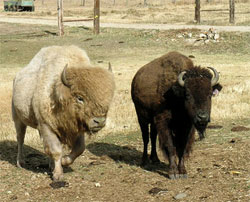 I'm
also pleading with those of you fully
acquainted with, and fully embracing,
White Buffalo Woman's story and the Seven
Sacred Rites that She brings. Be patient
with others of us as we seek to understand
some specific wisdom teachings embedded
within the whole story. It is a delicate
dance to find meaning in the part while
not necessarily embracing the whole but
this is the arrow threading through all
evolution - whether biological or spiritual.
And we are at a critical point in human's
spiritual evolution --- we are at a critical
point just as were the People when White
Buffalo first came to the Plains. I'm
also pleading with those of you fully
acquainted with, and fully embracing,
White Buffalo Woman's story and the Seven
Sacred Rites that She brings. Be patient
with others of us as we seek to understand
some specific wisdom teachings embedded
within the whole story. It is a delicate
dance to find meaning in the part while
not necessarily embracing the whole but
this is the arrow threading through all
evolution - whether biological or spiritual.
And we are at a critical point in human's
spiritual evolution --- we are at a critical
point just as were the People when White
Buffalo first came to the Plains.
In
noting the Seven Sacred Rites, it is
important to always bear in mind that
these are ceremonies for the whole village
- that is, Buffalo Medicine is focused
on the ills and the health of everyone
- including the larger world within which
the People live.
I
am listing these Steps in the order they
were given - as far as any historical
documentation is concerned. Then I will
choose the one or two that seem so acutely
relevant to us at this time. I am not
interested or competent to present some
full blown historical document on White
Buffalo Woman and/or the Seven Sacred
Rites. I am simply taking one story and
giving some perspectives on that story
for our shamanic community. However how
I share this story and the choice of
Rites to focus on is not based on my
simple self-interest but rather on what
I feel is the message coming on the first
Winds of Autumn, blowing cross my vision,
rousting me and perhaps the rest of you
towards preparation for Winter Long.
What's
important to remember is the song and
the promise that seemed to come from
the very breath of this White Buffalo
whether wearing her animal hide or her
Winter White Womanly garments:
"For
you who have lost your footing, for you
who walk out of balance, for you whom
grief is the habitat of your family,
here are the Steps that shall return
you and move you to health and the return
of your Soul as a People. The Whole Earth
aches for your return... and cannot be
without you whole. Please come Home... "
The
Seven Sacred Rites from White Buffalo
Woman:
- The Keeping of the Soul (Nagi Gluhapi
Na Nagi Gluxkapi)
- Purification or the Sweat Lodge
(Inipi)
- Crying for a Vision or the Vision
Quest (Hanblecheyapi)
- The Sun Dance (Wiwanyag Wachipi)
- The Making of Relatives (Hunkapi)
- Preparing for Womanhood or Puberty
Rite (Ishna T Awi Cha Lowan)
- Throwing the Ball (Tapa Wanka Yapi)
**An
historical note: "Throwing of the Ball" was
one of the original Seven Rites and was
replaced, at some point in the late 1800s
with a Healing Ceremony (Yuwipi) that
is done for healing and to practice "the
seeing way". Many now consider this considered
the Seventh Rite. I am listing both because
the "Throwing of the Ball" has significant
wisdom for our times
The
Grief of One Can Cloud the Eyes of Everyone
While meditating on these Seven Rites,
I found myself exploring their similarities
with major spiritual practices in other
cultures around the world.
I
was also intrigued with the fact that
The Keeping of the Soul is the first
step or ceremony that White Buffalo Woman
instructed the People to take. Obviously
Dying and Death are experiences that
all Beings have to address and find ways
of recognizing as an event that affects
everyone and not just the one who dies
at that particular moment or even just
one's loved ones.
However,
recognizing and announcing this as the
first and necessary ceremony to undertake
gives it a singular importance. In this
particular Rite, upon the death of the
individual, not only is there the burial
and prayers said for the departing Soul,
but some item connected with the one
who died, is set aside and tended for
a defined period of time. During this
time attention is paid to grieving. At
the end of a year, the Soul is completely
released and understood to have crossed
to Elsewhere.
I
started thinking about those still living,
for these are the ones who do the ceremony,
and why is it so important that the living
spend a certain amount of time tending
the Soul of the dead. That brought me
to thinking about the impact of grief
upon the living, upon the whole community.
I also thought; "how interesting
that I am writing about this topic at
this time of year. Here we are in the
midst of Autumn, Winter is only weeks
away. A major teaching for me in my life's
journey is that Winter is a most decisive
time during which some Beings shall not
survive the long Dark."
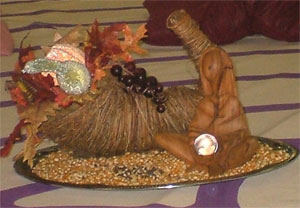 In
Autumn we bring in the Harvest; we set
aside supplies for the Winter; and we
prepare our shelters to endure the challenges
of this season. Preventive measures are
taken to ensure our immune systems are
active on our behalf. Focusing on this
step, I thought, is one way of aligning
appropriately with this seasonal shifting
now with us --- at least in the Northern
Hemisphere. In
Autumn we bring in the Harvest; we set
aside supplies for the Winter; and we
prepare our shelters to endure the challenges
of this season. Preventive measures are
taken to ensure our immune systems are
active on our behalf. Focusing on this
step, I thought, is one way of aligning
appropriately with this seasonal shifting
now with us --- at least in the Northern
Hemisphere.
And
why would NOT tending the Soul be seen
as such a major threat to the health
of a whole People? This question returns
me to the issue of loss and grief. How
is it that the grief of one, or of several,
could threaten the integrity of the whole,
of the many?
Grieving
for one who died, by its very nature,
takes our attention away from the Living
and attaches it to the one 'not here'
with us. As anyone who has grieved knows,
it is terribly difficult to be interested
in all the activities around us when
we are sickened in heart from our loss.
Even things requiring minimal attention
sometimes just seem impossible to attend...
and we can grow a resentment towards
those who want us Present and withdraw
ourselves even more. All Peoples recognize
and honor some grieving... and all spiritual
paths provide for some period of grieving---the
major difference among traditions has
to do with the length of time allowed
before the Call goes out "come to us,
come back to us" to the griever.
Lifting
of the Grief - Returning to the People
The most instructive understanding of
grief comes, for me, from the Iroquois
Condolence Ceremony. This is a ceremony
proscribed for 'the lifting of grief.'
Using contemporary language, basically
the one doing the lifting of grief from
another, speaks words that indicate why
it is so important to 'lift the grief'
from another. Preparation for the actual
ceremony instructs the grieving one to
make a necklace or string of wampum beads.
While making this, one is to grieve or
reflect upon the cause for the grieving.
The ceremony involves using this string
or necklace to wipe away or to lift the
grief and the effects of grieving.
It
is understood that of all human emotions,
grief is the one that most blocks us
from joining fully in the life of our
community, our world around us. It affects
all our senses and self-expression. For
example, during the ceremony, the one
lifting the grief takes the beaded string
in his or her hands and then uses that,
in a swiping motion, to wipe the tears
from the eyes so that one can now 'see'
life around and also envision a new world.
The obstruction in the ears is removed
and lifted away so that one can now hear
and listen... to the voices of the living
community. The grief caught in the throat
is removed and lifted so that one can
speak forth again and can speak one's
self... while also giving voice for and
on behalf of the community. Blockage
of the heart is removed and lifted so
that one can become newly attached and
heart-fully inclined to those around
one and to the whole community.
Finally,
a profound understanding is rendered
in that the memory of the loved one is
not removed but rather the memory becomes
the basis for a new story... a story
of one's self that has taken these memories
and uses them as part of the fuel for
being Present rather than removed (my
heart is 'elsewhere') from the community.
In
the Seven Sacred Rites from White Buffalo
Woman, all other actions, all other ceremonies,
are predicated on this lifting of grief
or this condolence ceremony. For how
can we move into any new direction or
create structures of transformation when
we are only partially Here and much of
our heart is focused Elsewhere.
In
reflecting on this ceremony, I wondered
how many of us take time in our lives
and in our circles to see if there are
others around us who have lost someone
or others of us who are stuck in and
with our grief for no one has come to
offer us such condolences. I wondered
for myself, too, have I shared and called
for my griefs to be lifted or did I park
them in an internal closet somewhere...
a closet where I spend attention from
time to time. If so, dare I open the
doors of my Being and trust my community
to help lift my grief - to clean out
my closet(s).
Sometimes
people share such losses with us or we
hear about them from some other person;
yet there are also times when such loss
occurs and no one else knows for the
one grieving has not the desire or energy
to so share. It might be useful to consider
raising this issue when we gather in
our circles whether physically or thru
our online communities; that is, let
the question be heard: "Have any of us
lost someone we love?" since last we
gathered. And if we find this to be the
case, to then take time for the one grieving
to share as fully as possible; to journey
and see what ceremony is appropriate,
and to be mindful of this loss over the
coming months.
In
other words, all spiritual paths recognize
death as a major event that affects everyone.
All spiritual paths recognize the Soul
has its own time of moving to Elsewhere
and the living have their own time of
mourning, of still being 'attached' to
the dead; and then comes a time of attachment
lessening and eventually a full return
to the living. In our shamanic community,
are we encouraging and encouraged to
tend both the Soul of the Dead and the
Souls of the Living... where and how
do we manifest this tending?
The
Making of Relatives
There are two more, of the seven, steps
that seem especially connected with the
focus of these three last newsletters:
- The Making of Relatives (Hunkapi)
and
- Throwing of the Ball (Tapa Wanka
Yap)
Together
with the Keeping of the Soul, they speak
to how the whole of the community
is strengthened and enabled to take
right action. The other four rites focus
on practices whereby the individual
takes action, sometimes independent of
anyone else, in order to find vision,
to cleanse or purify one's self, or to
recognize a new status in the community
(e.g. puberty or becoming a mother).
Again, all of these steps are ways of
restoring health and spirit but the reason
I am focusing on the communal aspects
is because these have become the
most neglected in our contemporary world
and yet they are the certain avenues
to finding our way to Home again.
Consider,
for example, how much the media plays
upon our fears of scarcity, our anxious
thoughts that others will have while
me and my family goes without... as though
there is some limited, defined amount
of food in the world and a limited supply
of love. If there be such a limited amount,
then there is a primordial place in each
of us that propels us to make sure we
have... and Then, perhaps, there is some
remaining amount we can share... whether
that be of material or non-material items.
The perception of limited resources,
held over time, inevitably leads to struggles
and conflict and a definition of 'who
is me' and 'who is not-me or not of mine.'
And just as in the White Buffalo Woman
story, probably half of the time we will
grasp for 'just-for-me and mine" and
half the time we shall give thought to "what
is there for the People."
And
in the midst of this scarcity mind-set
comes White Buffalo Woman saying,
I bring you seven steps to
take to restore health, abundance and
prospering of all. One of these steps
is to "make relatives;" that is,
to bring together others, to forge new
and strong relationships with others
and let this be manifested by the
giving and receiving of gifts, of sharing food,
conversation, and shelter. Thus shall
you bond with others in creating
extended family relationship.
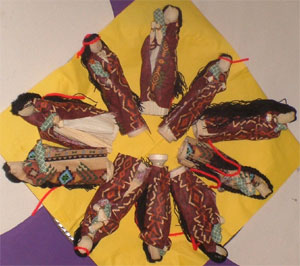 Such
a message coming, in the midst of scarcity
and war would seem to go against all
reasonable norms for human survival.
Yet it was the taking of these steps,
and the results of this step in particular,
that led to the forming of many different
tribes and peoples into one Nation -
that is, what the French labeled the
Sioux (composed of 7 different tribes)
yet which the tribes themselves translate
as we are "the People." By the People,
is meant I may speak Lakota, Mandan,
Hunkpapa, (etc.) but this is simply the
local language of those of us living
by River. I am also One with those living
near the Mountain or those in the Flat
Lands... of all you can see close and
beyond me I am One... we are 'the People.' Such
a message coming, in the midst of scarcity
and war would seem to go against all
reasonable norms for human survival.
Yet it was the taking of these steps,
and the results of this step in particular,
that led to the forming of many different
tribes and peoples into one Nation -
that is, what the French labeled the
Sioux (composed of 7 different tribes)
yet which the tribes themselves translate
as we are "the People." By the People,
is meant I may speak Lakota, Mandan,
Hunkpapa, (etc.) but this is simply the
local language of those of us living
by River. I am also One with those living
near the Mountain or those in the Flat
Lands... of all you can see close and
beyond me I am One... we are 'the People.'
Some
of the changes that occurred from living
these Seven Sacred Rites are lost to
contemporary consciousness. By the time
attention became focused on the Plains
Tribes, "the People" were already split
up into different groups and severely
dislocated, internally and externally,
by the conquest of those homelands. However,
from our Present Day vantage point, we
can imagine what great leaps of human
consciousness were made. It would be
equivalent for us to forge new bonds
and make relatives of those with whom
we now compete for resources. It would
be for us to make all our decisions based
on "every individual is a member of my
extended family." I don't assume this
was an easy nor ever completely achieved
task. The reason it is given as one of
the Seven Sacred Rites to be done regularly
is based on the recognition this is an
ongoing process yet remains the goal.
And each of the other rites somehow assists
us to transforming a splintered world
into a beautifully woven wholeness and
holiness.
(Pause...)
Shamanic
Synchronicity
A few minutes ago, while I was writing
the above paragraph, my friend Pirkko,
who lives in Indiana, called to share
with me a ceremony her Circle is doing
today. Part of the ceremony involves
the honoring of young mothers. They were
also making and providing Corn Dolls.
As she shared the activities to be done
tonight, I am full of wide-eyed listening.
I asked her to write this up, send some
photos, and we could put this at the
website to share with all of the community.
With utter delight and a sense of magic
unfolding, I exclaimed to Pirkko: "Your
Circle is doing the Fifth Ceremony of
White Buffalo Woman!!" and that's exactly
what I was writing about when you called.
It is the Making of Relatives. Talk about
synchronicity!"
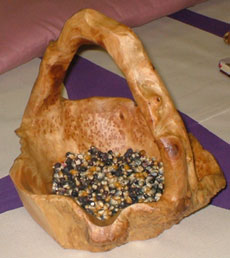 For
Pirkko is describing the bringing together
of women who lived in their greater neighborhood
yet were not part of their Circle. And
in this gathering, her Circle created
baskets of provisions for each woman
or mother to have during the coming Cold
Winter. Pirkko has her own
hope that these previous strangers will
come to know their Welcome and perhaps
return to future monthly gatherings.
This is one of those moments when it's
like Spirit rapping on the top of my
head and saying "now do you GET IT"... "Carol
do you see how important this is... I
am giving you all kinds of hints and
teachings so that you can see, practice
these, and share with others." For
Pirkko is describing the bringing together
of women who lived in their greater neighborhood
yet were not part of their Circle. And
in this gathering, her Circle created
baskets of provisions for each woman
or mother to have during the coming Cold
Winter. Pirkko has her own
hope that these previous strangers will
come to know their Welcome and perhaps
return to future monthly gatherings.
This is one of those moments when it's
like Spirit rapping on the top of my
head and saying "now do you GET IT"... "Carol
do you see how important this is... I
am giving you all kinds of hints and
teachings so that you can see, practice
these, and share with others."
So
I ask of us again, "Where are we making
relatives?" What are we doing with our
abundance, as a shamanic community, and
extending invitation to others "not of
us;" How are we sharing in provisions,
in conversations, and in giving and receiving
gifts. One of the marvelous teachings
in this Step is the recognition that
each person is given the call to 'give
and to receive'. For those of us with
scarce larders, how are we giving? Those
of us with full larders, how are we receiving.
This implies everyone has enough to give;
everyone has enough to receive. I just
delight in the understanding that brings
me... me with perhaps seeming 'nothing,'
has some thing I can give; and me with
seeming 'everything' still am asked to
receive.
Isn't
this simply delightful, trickster-type
wisdom... we if can just get it! and
live accordingly.
Tossing
the Earth Around
My closing remark on the Seven Steps
is to focus on the last original one: Throwing
of the Ball.
Using
a ball filled with Buffalo hair and a
Buffalo painted on the outside, the ball
would be tossed around, caught, held,
tossed. The ball represented the material
and spiritual aspects of Earth or of
the Universe. There is no predetermination
as to whom the ball will be tossed so
it requires constant alertness, readiness
to receive, readiness to pass on quickly
for part of the game is to keep the ball
moving rapidly. This is one of those
early games, played with delight and
laughter and with serious intention for
everyone present knew that they were
enacting their sacred responsibility
to be caretakers or holders of the Earth...
they were acknowledging their Ancestors
had held and passed on them and now is
their time to hold and pass onto their
descendants. Buffalo represents this
Earth and what they did with Buffalo,
they did to the Earth.
 I
have the same feeling now: we are tossing
Earth around and it is not a game in
which we can afford to drop Earth. Maybe
we should create some Earth Balls, get
our 'game faces' on, and do some serious
practicing while knowing this is for
Real. I
have the same feeling now: we are tossing
Earth around and it is not a game in
which we can afford to drop Earth. Maybe
we should create some Earth Balls, get
our 'game faces' on, and do some serious
practicing while knowing this is for
Real.
Interesting
enough, this is the last of the
Seven Sacred Rites. I've often wondered
is that because there is no returning
to the first if we don't succeed with
catching the Earth ball and/or is it
because once we have finished catching
and it is time to move on, we resume
the other ceremonies that bring us to
being able to catch Earth again, move
Earth among ourselves, and extend far
beyond.
In
closing, I want to share with you that
writing this monthly newsletter has grown
beyond what I originally thought I would
be doing. I assumed I'd be writing something
regarding the Seasons or Circling activities.
Instead I find myself wanting this to
be a useful way for us to think together
about other serious topics, too, and
focus on issues not usually addressed
but which have implications both for
the understanding and the practice of
shamanism. I have opened myself to Spirit
and dwell in the seat of the pupil while
writing these. I don't know quite where
I - or we - are going with this newsletter
but that's what it means to be a student.
I do know that I am open to focusing,
too, on any issue that might be of concern
to any one of you.. So, sometimes we
may be lead down the path of history
and sometimes something altogether different.
And
I am preparing another webpage to follow
up on points that have been raised in
letters to me. We are on a journey together
and I hope it is a journey you find useful
and enjoyable!
May
we enjoy and share the fruits we are
given... may we learn all the ways in
which we can make relatives, can lift
the grief, and toss the Ball.
Love
and blessings,
Carol
More
Information
For more of Carol's writings, you
can visit her website www.shamanicvisions.com
|



